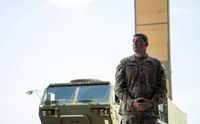The U.S. Army has pulled the curtain back on its Typhon mid-range missile system, showcasing it for the first time on Japanese soil at Marine Corps Air Station Iwakuni in southwestern Japan. The move, which took place on September 15, 2025, comes at a time of mounting regional tensions, particularly with China’s growing military assertiveness and ongoing disputes in the East China Sea and South China Sea.
This unveiling wasn’t just a solo act. It formed a central part of Resolute Dragon, the annual joint military exercise between the United States and Japan, which kicked off on September 8 and is scheduled to run until September 25. More than 19,000 U.S. and Japanese service members are taking part in the exercise, with a focus on maritime defense, littoral protection, and rehearsing responses to crisis scenarios. According to the U.S. Department of Defense, the exercises are scattered across Japan, emphasizing the defense of key maritime terrain and multidomain warfare.
The Typhon system itself is an impressive piece of hardware. It’s a ground-launched, truck-based platform capable of firing both the Standard Missile-6 (SM-6) and the Tomahawk cruise missile—both of which can reach targets along China’s eastern coastline. The system was delivered to Iwakuni in August 2025, arriving aboard an Air Force C-17 Globemaster III, and will remain at the base for the duration of the exercise. Its deployment marks a significant step in U.S.-Japan defense cooperation, given the growing missile arsenals in the region.
Despite the attention, the Typhon system won’t actually be fired during Resolute Dragon. Japanese public broadcaster NHK and Stars and Stripes report that the display is strictly for training and demonstration purposes. The U.S. Army’s plan is to familiarize Marines and Japanese troops with the system, rather than conduct live fire drills.
Colonel Wade Germann, commander of the U.S. Army’s 3rd Multi-Domain Task Force, addressed reporters at the base, stating, “Integrating this system into Resolute Dragon affords us the opportunity to conduct tough and realistic training with our partners.” He emphasized the flexibility and speed of the Typhon, saying, “It is designed to be expeditious and it is rapid and speedy.” Germann added, “Employing multiple systems and different types of munitions, it is able to create dilemmas for the enemy.”
He further elaborated, “What the 3rd Multi-Domain Task Force is able to do is provide multiple decisions that the enemy has to address. We do that by being able to operate in multiple domains, whether that be the air, the land, the sea, space and cyber simultaneously. The Typhon system is one system by which we can do that, but it’s integrated with a number of others.”
Typhon’s deployment in Japan follows its earlier appearances in the Philippines and Australia. In April 2024, the Pentagon deployed Typhon to the Philippines for an annual military exercise, a move that drew sharp criticism from both China and Russia. Although the system was not fired, its mere presence put southern Chinese military bases within range of U.S. Tomahawk missiles. In July 2025, Typhon was sent to Australia, where it fired an SM-6 missile at a maritime target—its first live use outside the continental United States.
The system’s rollout in Iwakuni is just the latest in a series of moves by the U.S. and its allies to counter China’s rapidly expanding missile arsenal and assertiveness in the region. According to Newsweek, Iwakuni is part of a chain of U.S. military bases stretching from Japan through the Philippines, forming a strategic arc designed to deter Chinese ambitions. The Typhon system, which draws on existing, easily mass-produced weapons, is seen as a way for the U.S. and its allies to keep pace with China’s military modernization.
Japan, for its part, has been accelerating its own military buildup. The government is particularly focused on developing mid- to long-range missile strike capabilities, a response not only to China’s growing power but also to persistent threats from North Korea and Russia. The recent sighting by Japan’s Defense Ministry of China’s newest aircraft carrier, the Fujian, in the East China Sea near the disputed Senkaku/Diaoyu islands, only adds to the urgency. These islands remain a flashpoint, with both Beijing and Tokyo laying claim.
Resolute Dragon isn’t just about Typhon. The U.S. military has also rolled out two other advanced weapons systems for the exercise: the Navy-Marine Expeditionary Ship Interdiction System (NMESIS) and the Marine Air Defense Integrated System (MADIS). Both are being deployed for the first time to Ishigaki Island, one of the westernmost outposts in the Ryukyu chain, which stretches from Kyushu to within 68 miles of Taiwan. This geographic proximity underscores just how close the military maneuvers are to some of the region’s most sensitive flashpoints.
Part of the exercise is about logistics and mobility—testing new ways to transport the Typhon system by land and sea. “This is a tremendous opportunity to integrate with our Marine counterparts, as well as our Japanese allies to learn from them and have them learn from us,” Germann said. The goal is to foster interoperability and ensure that both U.S. and Japanese forces are ready to respond quickly and effectively in a crisis.
Meanwhile, the U.S. and Japan are also beefing up their coast guard fleets. On September 9, the U.S. Coast Guard exercised a $507 million contract option to build 10 new Sentinel-class fast response cutters, which will help control and secure maritime approaches. Japan’s Mitsubishi Heavy Industries recently launched a new 3,500-ton coast guard vessel, scheduled for delivery in fiscal year 2026, further enhancing the country’s maritime law enforcement capabilities.
Of course, these moves haven’t gone unnoticed by Beijing and Moscow. Both China and Russia have accused the U.S. of fueling an arms race in the region, especially following Typhon’s earlier deployments. For Washington and Tokyo, however, the calculus is clear: as China asserts itself militarily and diplomatically, the U.S. and Japan are determined to present a united front, strengthen deterrence, and reassure their allies across the Pacific.
As Resolute Dragon continues, the presence of Typhon and other advanced systems sends a signal—not just of military might, but of the deepening partnership between the U.S. and Japan. With new threats emerging and old rivalries simmering, the region’s security landscape is shifting fast. The coming weeks will test not only the readiness of U.S. and Japanese forces, but also the resolve of those watching from Beijing, Moscow, and beyond.






